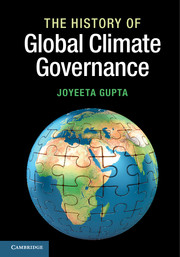Book contents
- Frontmatter
- Dedication
- Contents
- Foreword
- Preface and acknowledgements
- List of abbreviations
- Part 1 Introduction
- 1 Grasping the essentials of the climate change problem
- 2 Mitigation, adaptation and geo-engineering
- Part 2 The history of the negotiations
- Part 3 Issues in global climate governance
- Part 4 Towards the future
- References
- Index
2 - Mitigation, adaptation and geo-engineering
from Part 1 - Introduction
Published online by Cambridge University Press: 05 February 2014
- Frontmatter
- Dedication
- Contents
- Foreword
- Preface and acknowledgements
- List of abbreviations
- Part 1 Introduction
- 1 Grasping the essentials of the climate change problem
- 2 Mitigation, adaptation and geo-engineering
- Part 2 The history of the negotiations
- Part 3 Issues in global climate governance
- Part 4 Towards the future
- References
- Index
Summary
Introduction
The previous chapter presented the three big political dimensions of the climate change problem – the politics of science, the politics of governance and the politics of cooperation between rich and poor. This chapter now looks at the options for dealing with the climate change problem. It first argues that climate change is a development problem and that mitigation, adaptation and geo-engineering have impacts on development (see 2.2). It then looks at the measures that can be taken at different points of the climate change chain (see 2.3). For example, it examines measures to deal with the systemic nature of the problem (see 2.4), the underlying driving forces (see 2.5), the sources of climate change (see 2.6), GHG concentrations and global warming (see 2.7), adaptation (see 2.8) and residual impacts (see 2.9).
Climate change and development
Climate change is intrinsically linked to development. In order to address climate change, one can adopt mitigation measures to reduce GHG emissions and enhance sinks (e.g. afforest) that absorb these gases, adaptation measures that deal with the impacts of climate change, or adopt geo-engineering measures (large-scale interventions in the climate system) (see 2.7). Climate change mitigation and development have five key links. First, most societies and peoples wish to develop and the economic growth rate and employment are key to most election promises. Enhanced production, distribution and consumption brings with it increased GHG emissions. Second, emancipating the poor and providing them with access to basic resources, as called for in the Millennium Development Goals (UNGA, 2000a), will enable their meaningful participation in social production and consumption processes. This can potentially lead to enhanced GHG emissions, although it improves the resilience of the poor to climate impacts. Acceptance of the right of the poor to emancipate themselves implies acceptance of the need to differentiate between survival and luxury emissions (Agarwal and Narain, 1991; Opschoor, 2009). Third, development itself can lead to the conditions that can allow for mitigation: the rate of growth of these emissions can be influenced by the sustained application of appropriate policy choices, the use of win-win measures and the interconnectedness with other related policy decisions (IPCC-III, 2007).
- Type
- Chapter
- Information
- The History of Global Climate Governance , pp. 22 - 38Publisher: Cambridge University PressPrint publication year: 2014



